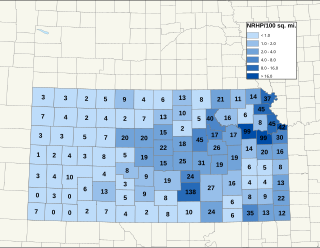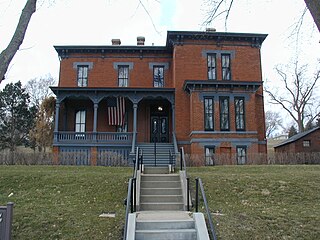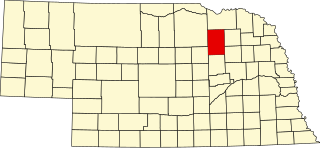
Lincoln is the capital city of the U.S. state of Nebraska and the county seat of Lancaster County. The city covers 100.4 square miles (260.035 km2) with a population of 292,657 in 2021. It is Nebraska's second-most populous city and the 73rd-largest in the United States. Lincoln is the economic and cultural anchor of a substantially larger metropolitan area in southeastern Nebraska, the Lincoln Metropolitan and Lincoln-Beatrice Combined Statistical Areas. The statistical area is home to 361,921 people, making it the 104th-largest combined statistical area in the United States.
The National Register of Historic Places (NRHP) is the United States federal government's official list of districts, sites, buildings, structures, and objects deemed worthy of preservation for their historical significance or "great artistic value". A property listed in the National Register, or located within a National Register Historic District, may qualify for tax incentives derived from the total value of expenses incurred in preserving the property.

The Minnesota Historical Society (MNHS) is a nonprofit educational and cultural institution dedicated to preserving the history of the U.S. state of Minnesota. It was founded by the territorial legislature in 1849, almost a decade before statehood. The Society is named in the Minnesota Constitution. It is headquartered in the Minnesota History Center in downtown Saint Paul.

Fort Robinson is a former U.S. Army fort and now a major feature of Fort Robinson State Park, a 22,000-acre (8,900 ha) public recreation and historic preservation area located 2 miles (3.2 km) west of Crawford on U.S. Route 20 in the Pine Ridge region of northwest Nebraska.

Fort Atkinson was the first United States Army post to be established west of the Missouri River in the unorganized region of the Louisiana Purchase of the United States. Located just east of present-day Fort Calhoun, Nebraska, the fort was erected in 1819 and abandoned in 1827. The site is now known as Fort Atkinson State Historical Park and is a National Historic Landmark. A replica fort was constructed by the state at the site during the 1980s–1990s.

Arbor Lodge State Historical Park and Arboretum is a mansion and arboretum located at 2600 Arbor Avenue, Nebraska City, Nebraska, United States. The park is a National Historic Landmark listed on the National Register of Historic Places since 1969.

There are over 1,400 buildings, sites, districts, and objects in Kansas listed on the National Register of Historic Places in Kansas. NRHP listings appear in 101 of the state's 105 counties.

This is a list of more than 1,100 properties and districts in Nebraska that are on the National Register of Historic Places. Of these, 20 are National Historic Landmarks. There are listings in 90 of the state's 93 counties.

The following is an alphabetical list of articles related to the U.S. State of Nebraska.

The Malcolm X House Site located at 3448 Pinkney Street in North Omaha, Nebraska, marks the place where Malcolm X first lived with his family. The site was listed on the National Register of Historic Places in 1984 and is also on the Nebraska list of heritage sites.

The General George Crook House Museum is located in Fort Omaha. The Fort is located in the Miller Park neighborhood of North Omaha, Nebraska, United States. The house was listed on the National Register of Historic Places in 1969, and is a contributing property to the Fort Omaha Historic District.

The South Omaha Main Street Historic District is located along South 24th Street between M and O Streets in South Omaha, Nebraska. It was added to the National Register of Historic Places in 1989. Home to dozens of historically important buildings, including the Packer's National Bank Building, the historic district includes 129 acres (0.52 km2) and more than 32 buildings.

The Omaha Rail and Commerce Historic District, roughly bounded by Jackson, 15th, and 8th Streets, as well as the Union Pacific main line, is located in downtown Omaha, Nebraska. Today this historic district includes several buildings listed individually on the National Register of Historic Places, including the Union Pacific Depot and the Burlington Station.

Camp Sheridan was established originally as the Post at Spotted Tail Indian Agency, near the Spotted Tail Agency in northwestern Nebraska in March 1874. In 1875, the garrison moved into permanent structures on the west fork of Beaver Creek, 12 miles upstream from the White River, near Hay Springs, Nebraska. The garrison, sometimes called Fort Sheridan, was abandoned seven years later in May 1881.

Fontenelle Forest is a 1,500-acre (6 km2) forest, located in Bellevue, Nebraska. Its visitor features include hiking trails, a nature center, children's camps, a gift shop, and picnic facilities. The forest is listed as a National Natural Landmark and a National Historic District. The forest includes hardwood deciduous forest, extensive floodplain, loess hills, and marshlands.

The Eggerss–O'Flyng Building is located at 801 South 15th Street in downtown Omaha, Nebraska, United States. The building was listed on the National Register of Historic Places in 1991, and named an Omaha Landmark on March 17, 1992.

The Senator George William Norris House is a historic house museum at 706 Norris Avenue in McCook, Nebraska. It was purchased in 1899 by George W. Norris (1862–1944), a Nebraska politician who championed the New Deal of the 1930s and the Rural Electrification Act. It was donated to the Nebraska State Historical Society in 1968 by his wife, and was designated a National Historic Landmark in 1967.

This is a list of the National Register of Historic Places listings in Cass County, Nebraska.

This is a list of the National Register of Historic Places listings in Lancaster County, Nebraska.

This is a list of the National Register of Historic Places listings in Antelope County, Nebraska.


























